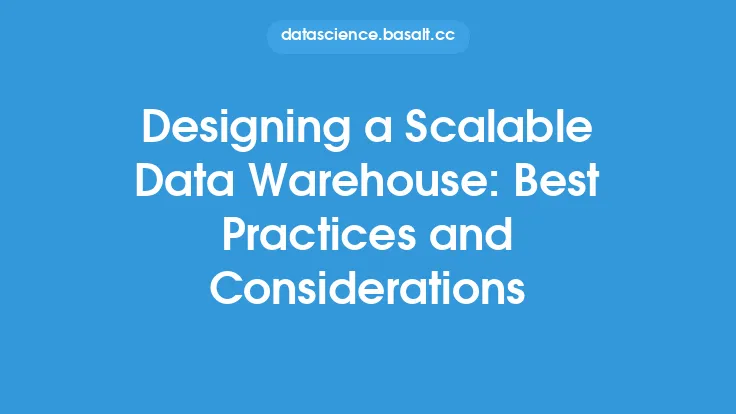Data warehousing is a crucial aspect of data engineering, and one of the key components of a data warehouse is its architecture. The architecture of a data warehouse refers to the way in which the data is organized and structured to support querying and analysis. There are several types of data warehouse architectures, including star, snowflake, and fact-constellation schemas. In this article, we will delve into the details of each of these architectures, comparing and contrasting their characteristics, advantages, and disadvantages.
Introduction to Data Warehouse Schemas
A data warehouse schema is a blueprint or a map that defines how the data is organized and related to each other. It is a critical component of a data warehouse, as it determines how the data is stored, accessed, and analyzed. A well-designed schema can improve the performance and scalability of a data warehouse, while a poorly designed schema can lead to slow query performance, data inconsistencies, and maintenance issues. There are several types of data warehouse schemas, including star, snowflake, and fact-constellation schemas, each with its own strengths and weaknesses.
Star Schema
A star schema is a type of data warehouse schema that consists of a central fact table surrounded by dimension tables. The fact table contains the measurable data, such as sales or revenue, while the dimension tables contain the descriptive data, such as date, customer, or product. The dimension tables are connected to the fact table through a single join, forming a star-like structure. Star schemas are simple, easy to maintain, and provide fast query performance. They are ideal for simple data warehouses with a small number of dimensions and facts. However, star schemas can become complex and difficult to manage as the number of dimensions and facts increases.
Snowflake Schema
A snowflake schema is an extension of the star schema, where each dimension table is further normalized into multiple related tables. This creates a more complex structure, with multiple joins between the fact table and the dimension tables. Snowflake schemas are more flexible and scalable than star schemas, as they can handle a large number of dimensions and facts. They are also more suitable for data warehouses with complex data relationships and hierarchies. However, snowflake schemas can be more difficult to maintain and optimize, and may require more advanced querying techniques.
Fact-Constellation Schema
A fact-constellation schema is a type of data warehouse schema that consists of multiple fact tables connected to a single set of dimension tables. This creates a constellation-like structure, with multiple fact tables sharing the same dimension tables. Fact-constellation schemas are ideal for data warehouses with multiple, related facts, such as sales, revenue, and profitability. They provide a flexible and scalable structure, allowing for easy addition of new facts and dimensions. However, fact-constellation schemas can be more complex and difficult to manage than star or snowflake schemas, and may require more advanced querying techniques.
Comparison of Star, Snowflake, and Fact-Constellation Schemas
Each of the three data warehouse schemas has its own strengths and weaknesses, and the choice of schema depends on the specific requirements and characteristics of the data warehouse. Star schemas are simple and easy to maintain, but may become complex and difficult to manage as the number of dimensions and facts increases. Snowflake schemas are more flexible and scalable, but may be more difficult to maintain and optimize. Fact-constellation schemas provide a flexible and scalable structure, but may be more complex and difficult to manage. The following table summarizes the key characteristics of each schema:
| Schema | Complexity | Scalability | Query Performance | Maintenance |
|---|---|---|---|---|
| --- | --- | --- | --- | --- |
| Star | Low | Low | High | Easy |
| Snowflake | Medium | High | Medium | Medium |
| Fact-Constellation | High | High | Medium | Difficult |
Best Practices for Designing a Data Warehouse Schema
Designing a data warehouse schema requires careful consideration of several factors, including the type of data, the querying requirements, and the scalability and performance needs. The following are some best practices for designing a data warehouse schema:
- Keep it simple: Avoid complex schemas with multiple joins and relationships.
- Use a consistent naming convention: Use a consistent naming convention for tables, columns, and indexes.
- Optimize for query performance: Design the schema to optimize query performance, using techniques such as indexing and partitioning.
- Consider scalability: Design the schema to scale with the growing needs of the data warehouse.
- Use data warehousing tools: Use data warehousing tools, such as data modeling software, to design and optimize the schema.
Conclusion
In conclusion, the choice of data warehouse schema depends on the specific requirements and characteristics of the data warehouse. Star, snowflake, and fact-constellation schemas each have their own strengths and weaknesses, and the best schema for a particular data warehouse will depend on the type of data, the querying requirements, and the scalability and performance needs. By following best practices for designing a data warehouse schema, and carefully considering the characteristics of each schema, data engineers can design a schema that meets the needs of their data warehouse and provides fast, scalable, and reliable query performance.





